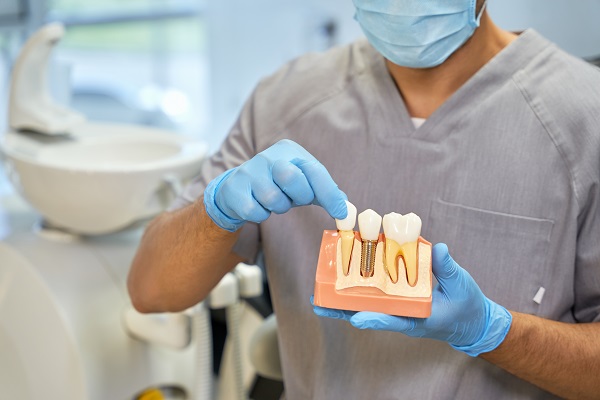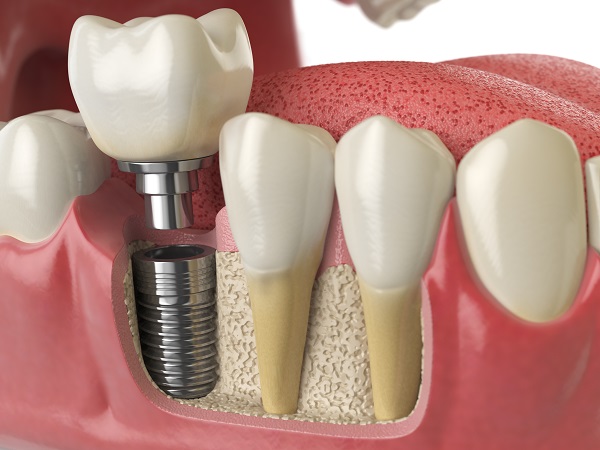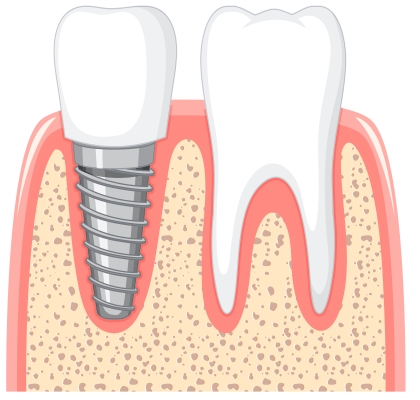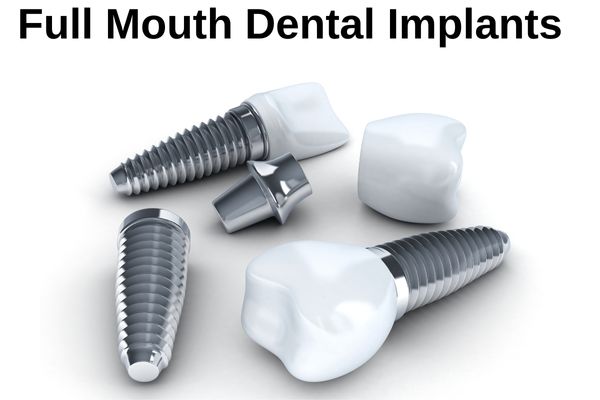
Turuncu Dental Clinic - Antalya - Turkey

While developments and technologies in dental and oral care are increasing rapidly, many people may lose their teeth due to tooth decay, periodontal diseases (periodontal) or dental and oral injuries. The current method for people who have lost teeth in the past years was bridges and prostheses.
Today, implant treatment is available for tooth loss. Implant tooth is the type of treatment with the closest look and feels to nature among the treatments to replace lost teeth. According to different types of tooth replacement, the dental implant system will not slip or click when we talk, laugh, eat, or drink.
In addition, implant teeth help preserve the structure of our face while giving health to the jawbone. With the screw tooth application, one of the tooth losses that cannot be treated with the filling method, you can both have an aesthetic smile and efficiently carry out your eating, drinking and speaking activities.
Implants are artificial tooth roots, usually made of titanium, that support the restoration of a missing tooth or teeth, help prevent or stop jawbone loss, and replace the tooth root. A screw thread is a surgical procedure applied to the lower / upper jaw to restore the chewing ability of a person who has lost a tooth or the appearance of the tooth.
Implants are a strong foundation for fixed (permanent) or removable replacement teeth that fit your teeth.
People who have lost their teeth cannot smile freely or even speak comfortably because they do not feel self-confident. Due to this loss, the person may even have a biting problem while eating or drinking.
Implants can be a good alternative to solve all these problems. The implant tooth also protects and stimulates the jawbone, preventing bone loss and helping the face maintain its shape. After the procedure and after a certain period, the implant becomes the best alternative to the natural tooth root.
Dental implant treatment is preferred because of tooth loss in people. The reasons for missing teeth are:

Dental implant treatment process is the determination of a personalized treatment plan and program. The plan is made by physicians who are experts in oral surgery and restorative dentistry, according to the patient's specific needs. Implant dental treatment is usually performed under local anesthesia without the patient being fully asleep. Although implant tooth placement is a surgical operation, it is a more comfortable application than a tooth extraction.
Before the operation, a preliminary examination is made by a specialist dentist. X-rays of the jawbone and other teeth are taken. The root implant, a small post usually made of titanium, is then placed in the bony socket of the missing tooth. Over time, the jawbone heals and grows around the implant, fixing it to the jaw.
An abutment is attached to the implant, which is attached to the jawbone and fixed to hold the new tooth. The dentist takes measures for the teeth to be placed, and a new model is arranged for the jaw. After this procedure, the replacement tooth can now be inserted into the area. Instead of individual crowns on the implant placed in the place of the lost teeth, attachments that hold and support the removable teeth can be placed in some patients.
For dental implant treatment, the replacement teeth will be arranged by your practitioner dentist in the closest way to the appearance of your natural teeth. The function and feel of your replacement teeth will be like your natural teeth.
In the treatments performed by specialist dentists, patients can have teeth that can smile comfortably without any pain. Your dentist can choose four dental implant treatment methods for you.
Implant treatment also called an immediate implant, is performed within one day. Tooth extraction and implant treatment are performed on the same day and in a single session. In this type of implant treatment, the comfort and practicality of the treatment make it a preferred method because there is no incision or suture. The patient can return to his daily life immediately after the treatment.
Which is called the seamless implant technique, is performed with the secure method. The operation is performed without incisions and stitches. In the seamless implant technique, a hole is opened in the chin area to be treated with a tool called a punch, where the implant will be placed. The implanted tooth is placed in the area through the opened slot. Again, since no surgical procedure is performed in this technique, it is not possible to see any side effects related to the procedure after the treatment.
In the mini-implant technique also called short implant application, which is generally preferred for posterior teeth, it may be necessary to add bone in cases where there is bone resorption in the lower / upper jaw due to tooth extraction due to the condition of the region and bone height decreases. If this situation is to be avoided, the mini-implant technique using short implants is a good alternative.
Dental implant treatment often requires a procedure that includes the healing phase. Implant treatment with multiple stages is considered an outpatient surgical procedure. The details will be explained below, and briefly and generally, the stages of implant construction are as follows:
Implant treatment takes a long process in which some stages are combined according to the type of treatment. The whole process can take months from start to finish. Most of a long time here is taken by the healing period that must go through for the permanent tooth to be inserted. At the beginning of the implant treatment process;
In the next section, the recovery phase takes place. Over time, the jawbone and the implant become fully compatible. In 2-6 months, the bone's fusion and growth occur. During this process, the jawbone grows towards the surface of the dental implant and fuses. At the end of this process, a solid foundation is formed in the artificial tooth to be inserted, just as the roots do for your natural teeth.
In the third stage, The abutment is placed. Once the jawbone has entirely accepted the implant (Osseointegration), surgery may be required to place the abutment – the piece to which the crown will eventually be attached – as an accessory. The procedure is performed under local anesthesia. To place the abutment:
In some cases, when the post is implanted in an application that does not require additional surgery, the abutment is attached to the metal post of the dental implant. The negative effect of this process is that it appears when the mouth is opened because the abutment crosses the gum line. This image will continue until the dentist completes the dental prosthesis. Patients who do not want this appearance during the healing period request that the abutment is made in a separate procedure.
Last stage; Once your gums have healed, impressions are taken by the dentist to make a realistic artificial tooth. This measure is used to make artificial teeth (crowns). For the crown to be placed, the jawbone is expected to heal completely. With your specialist dentist, you can decide how your artificial tooth will be. Your options include removable, fixed, or a combination of both artificial teeth.
Multiple factors determine how long the implant treatment will take to complete. Factors such as the patient's oral and dental health, the bone width of the jaw area, whether a bone graft or sinus augmentation will be performed, the number of teeth to be processed, the condition of the gums, how many extractions will be made if the tooth is to be extracted, when the screwed tooth process will be performed according to the tooth extraction process, and how long the treatment will be.
Are the factors that determine the end of time? Single-tooth implant application requires 15-20 minutes. At the same time, after the screwed tooth is inserted, the prosthesis can be applied on the implant after approximately 2-6 months, which should be waited for the tooth and jaw to adapt fully.
Multiple-factor screw thread costs are influential in determining implant costs. The experience and achievements of the specialist dentist, the implant brand, model and quality to be inserted, the number of implants to be placed, and the technique to be applied are important. We can count the factors that are effective in determining implant costs as follows:
Although these factors help determine implant costs, our specialist dentist can most accurately determine the most up-to-date Antalya dental implants costs.

The patient should have good general and oral health and healthy gum tissues that do not contain gum disease.
As with other forms of treatment, you must strictly follow the advice and instructions of your dentist. § implant treatment , tampons placed in the mouth should be kept inside for at least 30 minutes.
The instructions should use § implant treatment by your dentist. Antalya dental implants , nothing should be eaten or drunk for about 2 hours, and the consumption of extremely hot and cold foods should be avoided for at least one week. Hard foods should not be consumed for a while. It is possible to switch to normal nutrition within the period determined by the dentist.The control appointments scheduled by the dentist must be strictly followed.
The more implanted teeth are protected after the treatment, the more attention is paid to their care and cleaning, and the longer their life will be. It is predicted that the person can use their implants for 20-30 years without any problems, depending on the health of the jawbone and other factors.
Dental implant treatment can reach up to 98% depending on the reasons, such as whether the precautions are followed after the treatment, the experience of the dentist and the area of the jaw where the implants are placed.

Implant treatment Prosthetic teeth placed in the place of lost teeth in patients who have undergone surgery provide a more natural appearance than prostheses, which are one of the classical treatment methods. The treated patient will not only have a natural smile but also gain an aesthetic appearance and can speak comfortably.
Antalya dental implant application and tooth root application are performed. Since this application is not applied in the traditional prosthesis treatment, as time passes over the procedure, the jawbone area may be heavily loaded, and problems may arise in the jawbone. However, in implant treatment, the placed implant meets the pressure created while eating and drinking while protecting the jawbone against the adverse effects of this pressure.
These artificial teeth, which are generally similar to removable dentures, can be in the form of partial or complete dentures. Artificial white teeth are covered with pink plastic gum. The dental implant is fixed to the metal material connected to the auxiliary part (abutment). The artificial tooth can be easily removed for repair and maintenance.
This artificial tooth can either be screwed permanently or attached to an individual implant. Artificial teeth can not be easily removed during cleaning, maintenance, and sleep. Usually, each crown is placed on its dental implant. In addition, since the implants are durable, it is possible to replace more than one tooth with a single implant by bridging each other.

Full mouth implant treatment is an effective treatment applied in cases where the patient has no teeth or when several existing teeth have to be removed for various reasons (gingival recession, decay, sagging…). It is a treatment method that restores the lost oral health, dental aesthetics and dental functions in a way that will last a lifetime. (For detailed information about all on four implant treatment, read our “All On Four” article. For detailed information about all on six implant treatment, read our “All On Six” article.)
After the examination by our experienced dentists, our patients convey their expectations from the treatment to our dentists. Our dentists recommend each of our patients one of the most suitable “All on four, All on six and full dental implants(full mouth) treatments”.
After the implant teeth are placed in the jaw, fixed or removable prostheses and bridges are positioned in the jaw.
If the all-on-four technique is to be used while performing implant treatment in edentulous mouths, bridges are made on the implants placed in the jaw at different angles. Since there are no implants in the back of the jaw, the chewing force is not good enough. If the all on six technique is to be used in edentulous mouths, 6 implants are placed in the jaw at different angles. In this treatment, the bite force is better than the chewing force, but it may not be sufficient for the patients. It is very important to have a large number of implants for ideal and comfortable chewing.
The biggest advantage of full mouth dental implants treatment for the patient is that the teeth better meet the chewing force thanks to the implant teeth placed at every point of the jawbone. This allows patients to eat with the closest feeling to their natural teeth. In all three techniques, bridges are made between the teeth. Patients with full mouth implant treatment can use their bridges for a longer period of time. Because the number of implants that the bridge will support increases the durability of the bridge and thus its lifetime. Bridges with more abutments provide patients with better chewing function. Patients who want to achieve ideal chewing function should prefer full mouth implant treatment.
Our patients who have had full mouth dental implants dental treatment will get rid of all the discomforts caused by the removable full dentures (dentures) that come out of the mouth while laughing, talking, sneezing, coughing and consuming foods that have a slight stickiness, such as fresh bread. After having full mouth implant treatment, our patients eat freely, laugh, feel as if they have come back to life with their teeth that have regained their functions, and act more confidently in any environment.
If you want to get rid of the problems caused by total prosthesis (denture) from the problems of complete edentulism; If you want to regain the teeth and dental functions you lost for various reasons, as close to the natural tooth, we recommend you to have a full mouth dental implants tooth. We recommend that you come to our clinic to have a full mouth dental implants, have a preliminary examination, and get detailed information about the treatment process from our experienced physicians.
First: At least 6-8 implants are placed in the patient's chin. Fixed prostheses are placed on the placed implants and fixed. In this procedure, fixed prosthesis is preferred for the patient. The patient cannot remove their fixed prosthesis on their own. However, when the dentist comes to the dentist, the dentist can remove these fixed prostheses by using the necessary tools in the clinic.
Second: At least 6-8 implants are placed in the patient's chin. On top of these implants, removable prostheses are placed. These prostheses are produced in a snap-like model so that they can be mobile. In this way, the patient can remove removable dentures when needed in the home environment. It can provide cleaning by removing these prostheses.
If you want to get rid of the problems caused by the edentulous mouth and want to have a full mouth implant tooth; We recommend that you come to our clinic and talk to our experienced physicians.
Full dental implants treatment is not applied to all patients who are completely edentulous. In order to start full mouth implant treatment, the patient must comply with the criteria listed below. These criteria are:
Totally edentulous patients, patients who have to have all their teeth extracted, patients who cannot use total dentures, patients who want to regain the functions of their lost teeth can apply to our clinic for full mouth dental implants dental treatment if they meet the above criteria.
There is no upper age limit in implant treatment applications. Implant treatment for all individuals who are in good general health, over 18 and have completed bone development can do.
Medical treatment materials are subjected to many tests before they are used. Many studies have found no trace of the implant causing cancer. Dental implants are usually made of titanium material. On the other hand, titanium material is one of the most biologically compatible with the body. Titanium implants have been used for years, not only for teeth but also for different parts of the body. (Such as hip and knee prostheses) The body can sometimes reject the organ in heart and kidney transplants by producing antigen - antibodies. However, this is not possible in implant treatment.
The use of materials used in the dental treatment does not carry the risk of causing allergic reactions. Metals, prosthetic materials, mouthwashes, and toothpastes used in implant treatment can cause sensitivity and allergies in the mouth, although rarely.
Considering the general health status, medical history, and mouth and jawbone structure of the patient, the treatment can be performed in multiple sessions or completed in a single session, according to the results of the preliminary examination and the interview with the physician.
Bone strengthening can be done in patients with very weak and soft jawbones. Because our teeth apply pressure while chewing, there is a need for a bone structure that will remove this pressure and support the implant. A solid foundation for the implant can be created with a bone graft. There are several materials available for jaw bone regeneration with bone grafting.
These are natural bone grafts taken from another part of the body or synthetic bone grafts that can be used instead of bone. After the bone grafting of the jaw structure, an average of 2 months should be expected until it becomes suitable for the implant. If the bone graft to be made includes a small operation, it can be performed in the same session as the implant procedure. How the treatment will proceed will be decided by your specialist dentist.
Bacteria cannot damage implant teeth made of titanium or porcelain. The implant tooth, therefore, does not rot. The more importance is given to oral and dental care after treatment, the longer the lifespan.
An adverse condition such as cyst, edema, infection or bleeding is not detected in the jaw area where the implant will be treated. Dental implant application can be performed immediately after tooth extraction. If the ailments mentioned above have occurred in the chin, only implants can be made after recovery.
In order for the artificial tooth to be firmly established, the jawbone and the implant must be fully fused. This fusion period takes 2-3 months. During the healing and fusion period, oral and dental care must be done very well, and nutrition is carried out by the recommendations of the dentist.
Implant treatment, food should not be taken for at least 2-3 hours. Solid food consumption should be avoided for 24 hours following the treatment. Extremely cold-hot food and drink should not be consumed. Soft foods should be preferred over hard foods.
Those who have full dental implants can use their implants for 25 years or even 30 years without any problems if they take care of their oral and dental care, if they do not interrupt the doctor's checks that should be done twice a year, if the bone structure in their jaws is healthy, strong and sufficient.
Full mouth implant construction in edentulous mouths; The fusion period of the bone and the implant takes at least 4-6 months, including the completion of all sessions. The patient's attention to oral and dental health causes positive changes in the treatment period.
While performing implant dental treatment, porcelain veneer teeth and zirconium tooth veneers, which are frequently used in healthy natural-looking smile design processes with high light transmittance, are used especially in the front teeth. This makes the teeth look very natural.
If the patient meets all the necessary conditions for the implant and the general health condition is good, 12 -15 implants can be easily placed in the jaw in one day.
In edentulous patients, four implants can be placed if the all-on-four technique is to be used for fixed prosthetic bridges, six each if the all-on-six technique is to be used, or eight each, depending on the patient's bone tissue, if full-mouth implant dental treatment is to be applied.
Mild pain may occur after implant treatment. These pains can last up to about ten days. However, if the pain continues after this period, a dentist should be consulted.
Straumann implant is an implant manufacturer established in Switzerland in 1954, and the implant with the same name produced by the company is one of the most used brands in our country. This implant brand is preferred because of its aesthetics, durability and quality, as well as its many color options, easy shaping and giving the most natural results
It is one of the best alternatives, especially for young patients, people with orthodontic problems, and those sensitive to oral and dental health. With Straumann's short implants, treatment is carried out without limitation in vertical areas.
Local, general or sedation anesthesia methods can be used during dental implant treatment. The oral and maxillofacial surgeon will decide which anesthesia method is suitable for you. It is essential for the success of the treatment that you follow your doctor's recommendations on what to do before the treatment, according to the anesthesia method to be applied. If you have been treated with sedation or general anesthesia, you may need a companion when you go home after discharge.
All oral implant dentists can use their implants for 25 years or even 30 years without any problems if they take care of their oral and dental care if they do not interrupt the doctor's checks that should be done twice a year if the bone structure in their jaws is healthy, strong and sufficient
Just as an implant can be made instead of a single tooth, an implant can be made instead of each tooth of completely edentulous individuals. However, it is not recommended to have an implant tooth instead of every tooth.
Because very little bone tissue remains between the implants made in this way, this situation is not healthy for the patient's jaw structure, and the life of the implants made in this way is shortened. Implant placement with a bridge between them provides a healthier and longer-lasting treatment opportunity for the patient.
Full mouth implant construction in edentulous mouths; The fusion period of the bone and the implant takes at least 4-6 months, including completing all sessions. The patient's attention to oral and dental health causes positive changes in the treatment period.
While performing dental implant treatment, porcelain veneer teeth and zirconium tooth veneers, frequently used in healthy, natural-looking smile design processes with high light transmittance, are used especially in the front teeth. This makes the teeth look very natural.
The success rate of dental implant treatment is relatively high. The success rate of implants made by experienced physicians increases with the quality of the materials used and the care given to the patient's oral hygiene. Full chin implant treatment is long-lasting, highly durable, and comfortable.
If the patient meets all the necessary conditions for the implant and the general health condition is good, 12 -15 implants can be easily placed in the jaw in one day.
Suppose the all-on-four technique is used for fixed prosthetic bridges in edentulous patients. In that case, four implants can be placed, six each if the all-on-six technique is to be used, or eight implants each depending on the patient's bone tissue if full-mouth implant dental treatment is to be applied.
Many companies in the world produce implant teeth and/or other complementary parts of them. The dentist will select and apply one of these materials to determine the most appropriate treatment for the patient.
Generally, dental implant classification is divided into two, which are determined according to the methods and principles to be applied for placement. These: